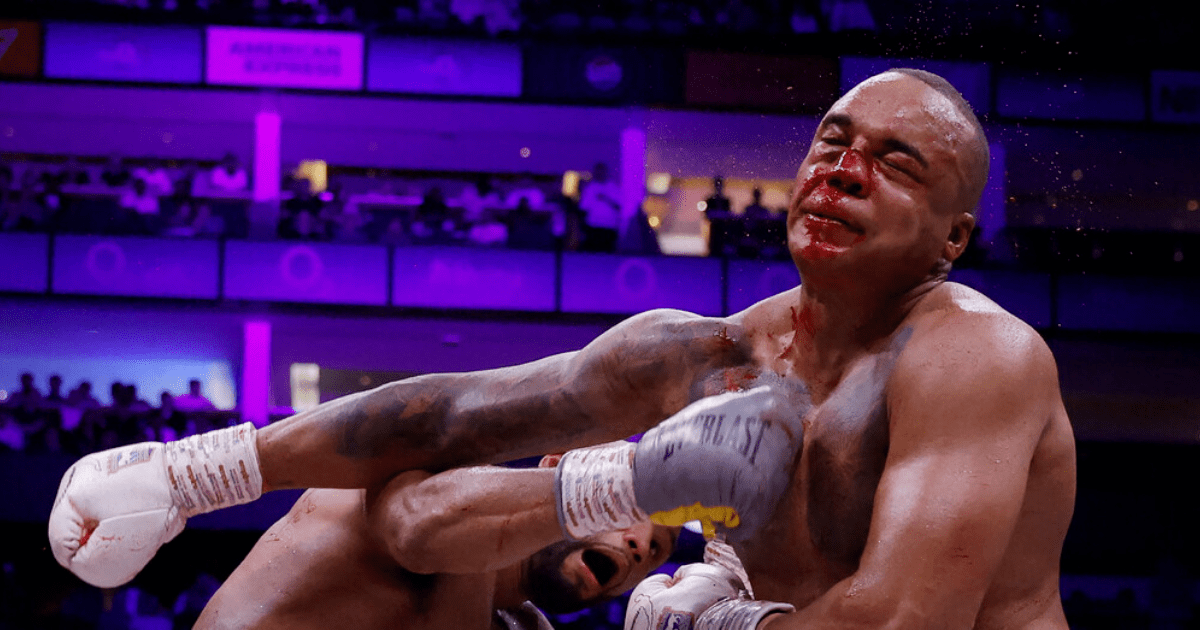Brave Battle Ends in a Draw
Fabio Wardley showed incredible determination as he survived a brutal broken nose to secure a draw against Frazer Clarke in a blood-soaked fight. Despite the injury, Wardley managed to retain his British heavyweight title in a thrilling match.
Intense Showdown
The fight, which saw Wardley spewing blood for most of the match, had fans on the edge of their seats. Both fighters exchanged evenly matched jabs, with Clarke showing impressive boxing skills and Wardley demonstrating resilience and heart.
Bloody Battle
Wardley's broken nose didn't deter him from delivering powerful shots, even as Clarke landed significant blows. The ring was left covered in blood as both fighters gave it their all, showcasing true grit and determination.
Heart of a Champion
Despite the grueling battle and Wardley's visibly injured state, he continued to fight on, landing impactful punches and showing incredible courage. The draw result left fans in awe of the fighters' determination and skill.

Potential Rematch
With both fighters leaving everything in the ring, speculation about a rematch between Wardley and Clarke is already circulating. Clarke's relentless performance and Wardley's resilience have left fans eager to see these warriors face off again.
Frequently Asked Questions
What are professional boxing’s risks?
Professional boxing, like any contact sport, carries inherent risks. They include acute injuries, such as cuts and bruises, broken bone, head trauma, and potential chronic conditions caused by repeated impacts, such concussion syndromes, or neurological disorders. Proper training, safety equipment, and adherence to boxing regulations help mitigate risks, but they can never be fully eliminated. To box professionally, you must accept these risks and be able to recognize them.
How important is physical training in professional boxing?
Boxing is a sport that requires physical fitness. The sport demands a high level of strength, speed and endurance. Professional boxers are required to follow a fitness regimen that includes anaerobic and aerobic exercises, resistance and strength training, as well as flexibility workouts. Boxers’ ability to perform and train effectively in the ring will be compromised if they do not have superior physical condition.
Are there age restrictions for learning to box professionally?
Age restrictions do exist in professional boxing. Most boxing organizations require boxers to be 18 years old or older before they can fight professionally. Although there is not a set age limit for the upper age bracket, factors like physical capability and health will naturally limit what age one can safely and effectively compete. It’s crucial for older athletes to be thoroughly assessed for fitness and risk before taking up the sport professionally.
How long does it typically take to become a professional boxer?
The time needed to become a professional fighter can vary greatly. It depends on the individual’s starting skill level, adaptability to the sport, and the quality of training received. It may take several years for a dedicated amateur athlete to reach the level of a professional. Some talents will develop faster than others.
How do amateurs progress to professional boxers?
The transition from amateur boxing to professional requires a significant increase in training intensity and mental preparation. An amateur boxer is required to establish a record of success, usually by honing their skills at local and national contests. It is also critical to obtain a professional boxing license and align with experienced managers and trainers who can guide career decisions and secure professional bouts.
How important mental toughness is it in professional Boxing?
Mental toughness is as vital as physical conditioning in professional boxing. The sport requires resilience, focus and the ability to handle stress, as well as the psychological fortitude needed to overcome adversity. Mental preparation includes visualization, stress management, and developing a mindset that is ready to face the challenges in the ring. Without mental toughness a boxer will struggle to perform under the high pressure conditions of professional competition.
What are the requirements to train for professional boxing?
Before beginning to train for professional boxing one must be committed to physical fitness and discipline. They also need to have an eagerness to learn. In the beginning, you will need to master basic fundamentals such as stance, footwork and punches. You should join a reputable gym with trainers who are experienced and understand the nuances in professional boxing competition. Before they compete, novice boxers usually undergo a regimen of intense conditioning, drills and sparring.
Statistics
- A study showed that most professional boxers have spent more than 4 years in training before their first professional bout.
- Around 60% of professional boxers supplement their income with other activities or jobs, due to variability in fight earnings.
- Reports suggest that successful professional boxers can earn upwards of 50 times more than the median purse for entry-level professionals per fight.
- Professional boxers typically train 4 to 6 hours per day, 5 to 6 days a week, depending on their fight schedule.
- Less than 10% of professional boxers are undefeated throughout their career, highlighting the sport’s competitive nature.
- On average, a professional boxer spars between 100 to 200 rounds in preparation for a major fight.
- Approximately 80% of professional boxers start their career in the amateur ranks before transitioning to the professional level.
External Links
titleboxing.com
ringtv.com
precisionstriking.com
usaboxing.org
expertboxing.com
ibhof.com
boxingnews24.com
How To
How to improve boxing defense
Improving defense is as important as perfecting your offense in professional boxing. Focus on footwork, blocking, and head movements. Regularly practice slipping, bobbing, weaving, and the use of angles to evade punches. Use defensive maneuvers during sparring sessions to create muscle memory under live conditions. You can use your sparring experience to identify your defensive weaknesses. Work with your coach to improve them. The outcome of your fights can be significantly affected by how well you defend.

